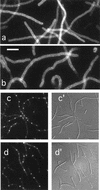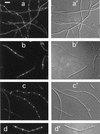Recruitment of ZipA to the septal ring of Escherichia coli is dependent on FtsZ and independent of FtsA
- PMID: 9864327
- PMCID: PMC103546
- DOI: 10.1128/JB.181.1.167-176.1999
Recruitment of ZipA to the septal ring of Escherichia coli is dependent on FtsZ and independent of FtsA
Abstract
Cell division in prokaryotes is mediated by the septal ring. In Escherichia coli, this organelle consists of several essential division proteins, including FtsZ, FtsA, and ZipA. To gain more insight into how the structure is assembled, we studied the interdependence of FtsZ, FtsA, and ZipA localization using both immunofluorescence and Gfp tagging techniques. To this end, we constructed a set of strains allowing us to determine the cellular location of each of these three proteins in cells from which one of the other two had been specifically depleted. Our results show that ZipA fails to accumulate in a ring shape in the absence of FtsZ. Conversely, depletion of ZipA does not abolish formation of FtsZ rings but leads to a significant reduction in the number of rings per unit of cell mass. In addition, ZipA does not appear to require FtsA for assembly into the septal ring and vice versa. It is suggested that septal ring formation starts by assembly of the FtsZ ring, after which ZipA and FtsA join this structure in a mutually independent fashion through direct interactions with the FtsZ protein.
Figures






Similar articles
-
Unique and overlapping roles for ZipA and FtsA in septal ring assembly in Escherichia coli.EMBO J. 2002 Feb 15;21(4):685-93. doi: 10.1093/emboj/21.4.685. EMBO J. 2002. PMID: 11847116 Free PMC article.
-
Escherichia coli ZipA Organizes FtsZ Polymers into Dynamic Ring-Like Protofilament Structures.mBio. 2018 Jun 19;9(3):e01008-18. doi: 10.1128/mBio.01008-18. mBio. 2018. PMID: 29921670 Free PMC article.
-
ZipA Uses a Two-Pronged FtsZ-Binding Mechanism Necessary for Cell Division.mBio. 2021 Dec 21;12(6):e0252921. doi: 10.1128/mbio.02529-21. Epub 2021 Dec 14. mBio. 2021. PMID: 34903053 Free PMC article.
-
Anchors: A way for FtsZ filaments to stay membrane bound.Mol Microbiol. 2023 Oct;120(4):525-538. doi: 10.1111/mmi.15067. Epub 2023 Apr 28. Mol Microbiol. 2023. PMID: 37503768 Free PMC article. Review.
-
In the beginning, Escherichia coli assembled the proto-ring: an initial phase of division.J Biol Chem. 2013 Jul 19;288(29):20830-20836. doi: 10.1074/jbc.R113.479519. Epub 2013 Jun 5. J Biol Chem. 2013. PMID: 23740256 Free PMC article. Review.
Cited by
-
FtsZ ring stability: of bundles, tubules, crosslinks, and curves.J Bacteriol. 2013 May;195(9):1859-68. doi: 10.1128/JB.02157-12. Epub 2013 Mar 1. J Bacteriol. 2013. PMID: 23457247 Free PMC article. Review.
-
A predicted ABC transporter, FtsEX, is needed for cell division in Escherichia coli.J Bacteriol. 2004 Feb;186(3):785-93. doi: 10.1128/JB.186.3.785-793.2004. J Bacteriol. 2004. PMID: 14729705 Free PMC article.
-
The bypass of ZipA by overexpression of FtsN requires a previously unknown conserved FtsN motif essential for FtsA-FtsN interaction supporting a model in which FtsA monomers recruit late cell division proteins to the Z ring.Mol Microbiol. 2015 Mar;95(6):971-87. doi: 10.1111/mmi.12907. Epub 2015 Feb 4. Mol Microbiol. 2015. PMID: 25496259 Free PMC article.
-
Fatty Acid Availability Sets Cell Envelope Capacity and Dictates Microbial Cell Size.Curr Biol. 2017 Jun 19;27(12):1757-1767.e5. doi: 10.1016/j.cub.2017.05.076. Epub 2017 Jun 8. Curr Biol. 2017. PMID: 28602657 Free PMC article.
-
FtsA reshapes membrane architecture and remodels the Z-ring in Escherichia coli.Mol Microbiol. 2018 Feb;107(4):558-576. doi: 10.1111/mmi.13902. Epub 2018 Jan 8. Mol Microbiol. 2018. PMID: 29280220 Free PMC article.
References
Publication types
MeSH terms
Substances
Grants and funding
LinkOut - more resources
Full Text Sources
Other Literature Sources
Molecular Biology Databases

